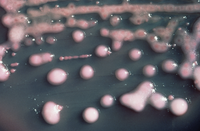
Photo from wikipedia
Dissemination of carbapenem resistance among pathogenic Gram-negative bacteria is a looming medical emergency. Efficient spread of resistance within and between bacterial species is facilitated by mobile genetic elements. We hypothesized… Click to show full abstract
Dissemination of carbapenem resistance among pathogenic Gram-negative bacteria is a looming medical emergency. Efficient spread of resistance within and between bacterial species is facilitated by mobile genetic elements. We hypothesized that wastewater contributes to the dissemination of carbapenemase-producing Enterobacteriaceae (CPE), and studied this through a cross-sectional observational study of wastewater in the East of England. We isolated clinically relevant species of CPE in untreated and treated wastewater, confirming that waste treatment does not prevent release of CPE into the environment. We observed that CPE-positive plants were restricted to those in direct receipt of hospital waste, suggesting that hospital effluent may play a role in disseminating carbapenem resistance. We postulated that plasmids carrying carbapenemase genes were exchanged between bacterial hosts in sewage, and used short-read (Illumina) and long-read (MinION) technologies to characterize plasmids encoding resistance to antimicrobials and heavy metals. We demonstrated that different CPE species (Enterobacter kobei and Raoultella ornithinolytica) isolated from wastewater from the same treatment plant shared two plasmids of 63 and 280 kb. The former plasmid conferred resistance to carbapenems (blaOXA-48), and the latter to numerous drug classes and heavy metals. We also report the complete genome sequence for Enterobacter kobei. Small, portable sequencing instruments such as the MinION have the potential to improve the quality of information gathered on antimicrobial resistance in the environment.
Journal Title: Microbial Genomics
Year Published: 2017
Link to full text (if available)
Share on Social Media: Sign Up to like & get
recommendations!